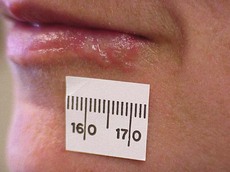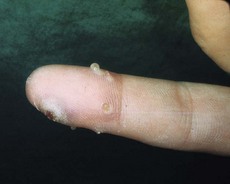157 Herpes labialis
Salient features
Questions
Advanced-level questions
What are the complications of herpes infections?
• Disseminated infection in the immunocompromised individual
• Herpes keratitis, scarring and visual impairment
• Herpes simplex encephalitis (propensity for the temporal lobe)
• Herpetic whitlow (infection of the finger) (Fig. 157.2)
• Herpes gladiatorum (infection of the skin, described among wrestlers)
• Visceral infections, especially in viraemia in HIV (oesophagitis, pneumonitis, hepatitis)
• Neonatal HSV infection (neonates <6 weeks of age); usually visceral and/or CNS infection
• CNS complicatiosn: aseptic meningitis, sacral radiculopathy, transverse myelitis and benign recurrent lymphocytic meningitis (Mollaret’s meningitis).
How would you confirm your clinical diagnosis?
• Scrapings of the base of the lesions stained with Wright, Giemsa (Tzanck preparation) or Papanicolaou’s stain will demonstrate characteristic giant cells or intranuclear inclusions of herpes infection (does not differentiate from zoster infection)
• Isolation of virus in tissue culture
• Demonstration of HSV antigens in scrapings from lesions
• HerpeSelect HSV-1 and HSV-2 enzyme-linked immunosorbent assays and HSV-1 and HSV-2 immunoblot tests.
What drugs are available for herpes simplex infections?
• Mucocutaneous herpes: topical aciclovir, valaciclovir, famciclovir, foscarnet
• Eye infections: idoxuridine, trifluorothymidine, topical vidarabine. Prophylactic use of aciclovir can prevent recurrent ocular HSV disease (N Engl J Med 1998;339:300–6)
• Encephalitis: intravenous aciclovir
• Neonatal infections: high-dose intravenous vidarabine and aciclovir.









